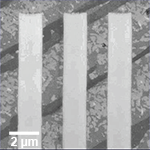Published/Posted: March 3, 2017
Authors: Daniels, K. M.; Jadidi, M. M.; Sushkov, A. B.; Nath, A.; Boyd, A. K.; Sridhara, K.; Drew, H. D.; Murphy, T. E.; Myers-Ward, R. L.; Gaskill, D. K.
Abstract: Exploiting the underdeveloped terahertz range (10^12–10^13 Hz) of the electromagnetic spectrum could advance many scientific fields (e.g. medical imaging for the identification of tumors and other biological tissues, non-destructive evaluation of hidden objects or ultra-broadband communication). Despite the benefits of operating in this regime, generation, detection and manipulation have proven difficult, as few materials have functional interactions with THz radiation. In contrast, graphene supports resonances in the THz regime through structural confinement of surface plasmons, which can lead to enhanced absorption. In prior work, the achievable plasmon resonances in such structures have been limited by multiple electron scattering mechanisms (i.e. large carrier scattering rates) which greatly broaden the resonance (>100 cm−1; 3 THz). We report the narrowest room temperature Drude response to-date, 30 cm−1 (0.87 THz), obtained using quasi-free standing bilayer epitaxial graphene (QFS BLG) synthesized on (0001) 6H–SiC. This narrow response is due to a 4-fold increase in carrier mobility and improved thickness and electronic uniformity of QFS BLG. Moreover, QFS BLG samples patterned into microribbons targeting 1.8–5.7 THz plasmon resonances also exhibit low scattering rates (37–53 cm−1). Due to the improved THz properties of QFS BLG, the effects of e-beam processing on carrier scattering rates was determined and we found that fabrication conditions can be tuned to minimize the impact on optoelectronic properties. In addition, electrostatic gating of patterned QFS BLG shows narrow band THz amplitude modulation. Taken together, these properties of QFS BLG should facilitate future development of THz optoelectronic devices for monochromatic applications.Citation:
K. M. Daniels, M. M. Jadidi, A. B. Sushkov, A. Nath, A. K. Boyd, K. Sridhara, H. D. Drew, T. E. Murphy, R. L. Myers-Ward and D. K. Gaskill, "Narrow plasmon resonances enabled by quasi-freestanding bilayer epitaxial graphene", 2D Mater. 4(2) 025034 (2017)
Export: BibTeX | RIS
Manuscript: Daniels_2DMater_4_025034_2017.pdf
